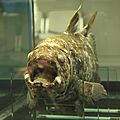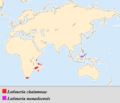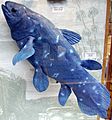Coelacanth facts for kids
Quick facts for kids CoelacanthsTemporal range: Devonian – Recent
|
|
|---|---|
 |
|
| Latimeria chalumnae, Natural History Museum, Vienna (170 cm; 60 kg). Caught 18 October 1974, off Grand Comoro, Comoro Islands. 11°48′40.7″S 43°16′3.3″E / 11.811306°S 43.267583°E. |
|
| Scientific classification | |
| Kingdom: | |
| Phylum: | |
| Class: | |
| Subclass: |
Coelacanthimorpha
|
| Order: |
Coelacanthiformes
Berg, 1937
|
A coelacanth is a very special type of fish. It belongs to a group called lobe-finned fishes. These fish are closely related to the animals that eventually evolved into tetrapods. Tetrapods are creatures with four limbs, like amphibians, reptiles, birds, and mammals.
Scientists have found fossils of coelacanths that are 400 million years old. This was long before any animals lived on land! For a long time, people thought coelacanths had died out 80 million years ago. But then, two species were found alive in the Indian Ocean. The first one was caught near the east African coast in 1938.
Contents
What Makes Coelacanths Special?
Coelacanths are an important link between fish and the first amphibians. Amphibians were the first animals to move from the sea to land. This happened during the Devonian period, about 408 to 362 million years ago.
Early fish that moved to land often lived in shallow, muddy water near the shore. But coelacanths lived in open water. Today's coelacanths are predators. They live deep in the ocean.
Latimeria: The Living Fossil
Latimeria is the only living genus (group of species) of coelacanth fish. All other coelacanths are only known from fossils. Because it was thought to be extinct for so long, Latimeria is known as a "Lazarus taxon." This means it's like it came back from the dead!
It's rare for such a large creature to remain hidden for so long. But the cold, deep waters of the West Indian Ocean, where the coelacanth lives, may have helped it survive. Also, it doesn't have many predators. Its taste is not very good, so fishermen didn't try to catch it on purpose. That changed when scientists started offering rewards to find them!
The coelacanth population near Tanzania faces a threat from Japanese trawlers. These fish are not eaten, but they are sometimes caught by accident in the trawls.
How Was Latimeria Discovered?
The first Latimeria was found in 1938. Marjorie Courtenay Latimer discovered it. She was a museum curator in East London, a port town in South Africa. She was visiting a fisherman and looking through his catch for interesting specimens.
The second species of coelacanth was found in 1952. It was discovered off the Comoros islands in the Indonesian archipelago. The largest coelacanth ever found was about 1.8 meters (nearly 6 feet) long.
Images for kids
-
Fossil of Coelacanthus granulatus, the first described coelacanth, named by Louis Agassiz in 1839
-
Reconstruction of West Indian Ocean coelacanth
-
Pectoral fin of a West Indian Ocean coelacanth
-
Latimeria chalumnae model in the Oxford University Museum of Natural History, showing the coloration in life.
-
Latimeria chalumnae embryo with its yolk sac from the Muséum national d'histoire naturelle
See also
 In Spanish: Celacanto para niños
In Spanish: Celacanto para niños













